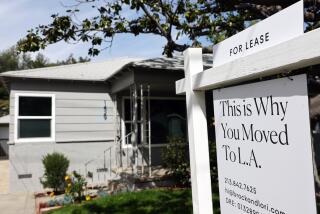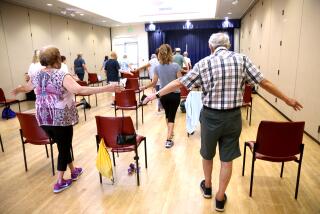Fitting the home to its aging owner
- Share via
As we carried the last boxes -- silverware, dishes, favorite kitchen seasonings -- up the stairs to my mom’s newly rented condominium, my brother stared me down with a sweat-stained grin.
“Am I nuts, or will we be doing this again in a couple of years?” Bill asked. “Mom’s not going to be carrying groceries up these stairs forever.”
That was four short years ago. The steps were few -- half a dozen reaching from the basement garage to her first-floor unit -- but far too many for a woman, now 83, to take more than once a day.
Earlier this year, the siblings moved Mom into another condominium across the street, complete with a spacious elevator.
The unit was larger than the previous one so that the kids -- and grandkids -- could continue to visit. The second bedroom also afforded the possibility of live-in care down the road.
And, for the first time, we all were more aware of bathtubs with grab bars, wider hallways and the height of the counter tops.
I thought about that move recently not just for my mom, but also for my wife and myself.
According to AARP, the organization formerly known as the American Assn. of Retired Persons, nearly a quarter of Americans age 45 or older say they or someone they live with will have trouble maneuvering around their home in the coming years.
A survey by the group -- the United States’ largest organization for those 50 and older -- showed that fewer than 10% of the nation’s 100 million housing units have features to make them universally accessible.
The good news is that the nation’s home builders now recognize the needs of consumers who will soon require grab bars and prefer one-story homes.
At the recent National Assn. of Home Builders’ Senior Housing Symposium, the country’s first certified aging-in-place specialists, those who help people remain in their homes as they age, completed training for a new professional designation.
‘Enthusiastic response’
The three-day seminar provided information about aging-in-place home modifications, including background on the older adult population, common remodeling projects, marketing, codes and standards, common barriers and solutions, product ideas, resources and communication.
“The enthusiastic response to the new training and professional standards from consumers, remodelers and professionals in a variety of related fields affirms the timeliness of this important initiative,” said Bill Owens, the NAHB’s remodelor’s council chairman and a remodeling contractor.
Projects for the aging-in-place remodeling segment range from installation of bath and shower grab bars and adjustment of counter heights to the creation of multi-function first-floor master suites and the installation of private elevators. Participants learned to assess clients’ needs and determine attractive, functional solutions.
Just how many aging boomers are in the pipeline? According to the National Assn. of Realtors, about 3.2 million members of the baby-boom generation will turn 55 this year.
About 80% of all Americans 55 years or older own their own homes, the highest rate of homeownership of any age group in the country.
Members of this population group also tend to be healthier and wealthier than previous generations of similar age, and expect their homes to reflect their active, independent and upscale lifestyles, NAR reported.
For now, my wife and I have our home and our health. Yet, what type of changes will be needed, and how far down the road, if we plan to stay here? How will we pay for them?
Clearly, there is no condominium across the street with a spacious elevator.
*
Tom Kelly, former real estate editor for the Seattle Times, is a syndicated columnist and talk show host. Send questions and comments to news@tomkelly.com.
More to Read
Sign up for Essential California
The most important California stories and recommendations in your inbox every morning.
You may occasionally receive promotional content from the Los Angeles Times.






